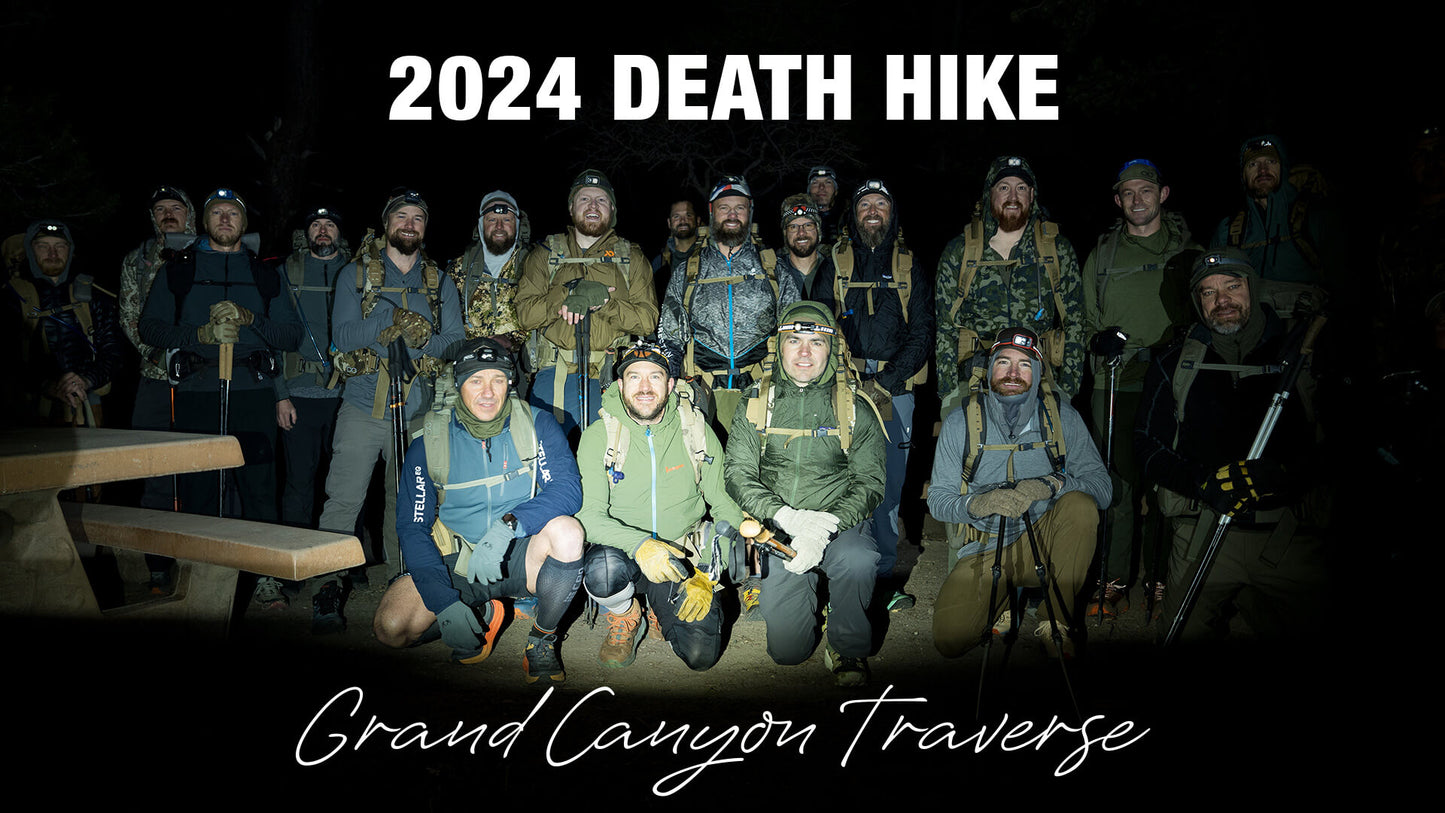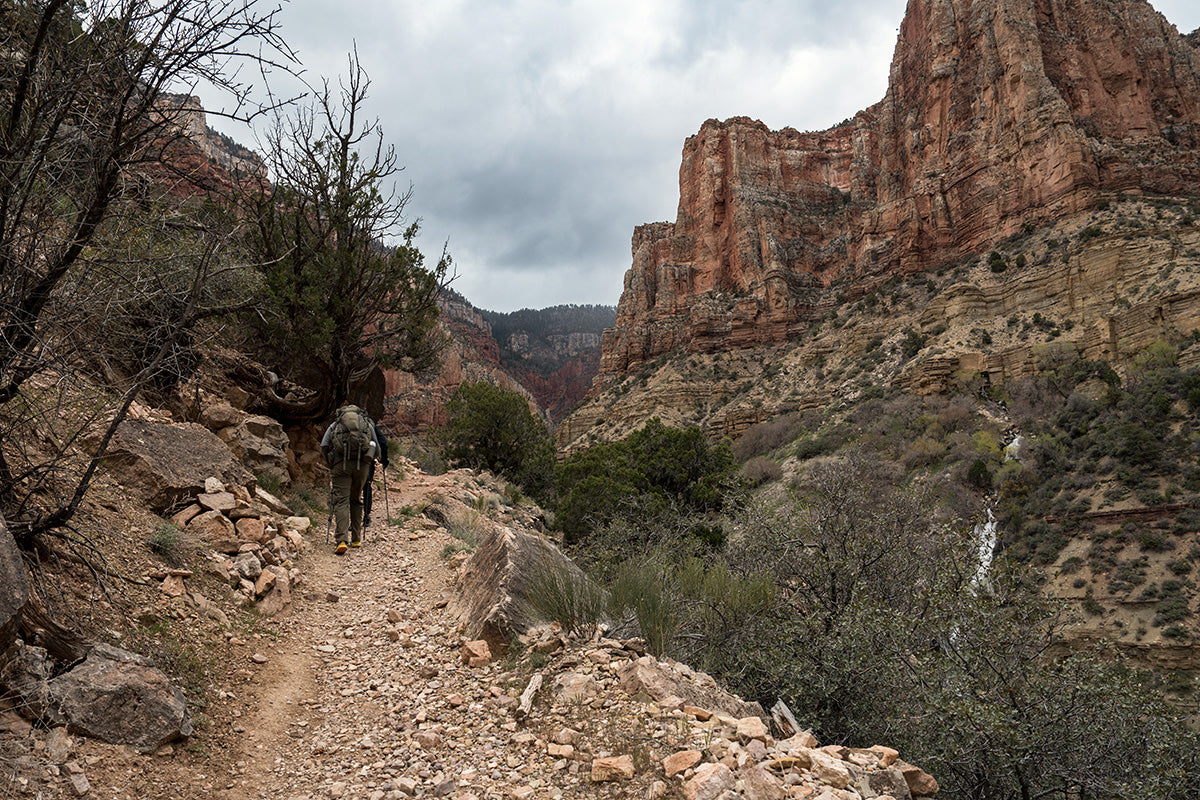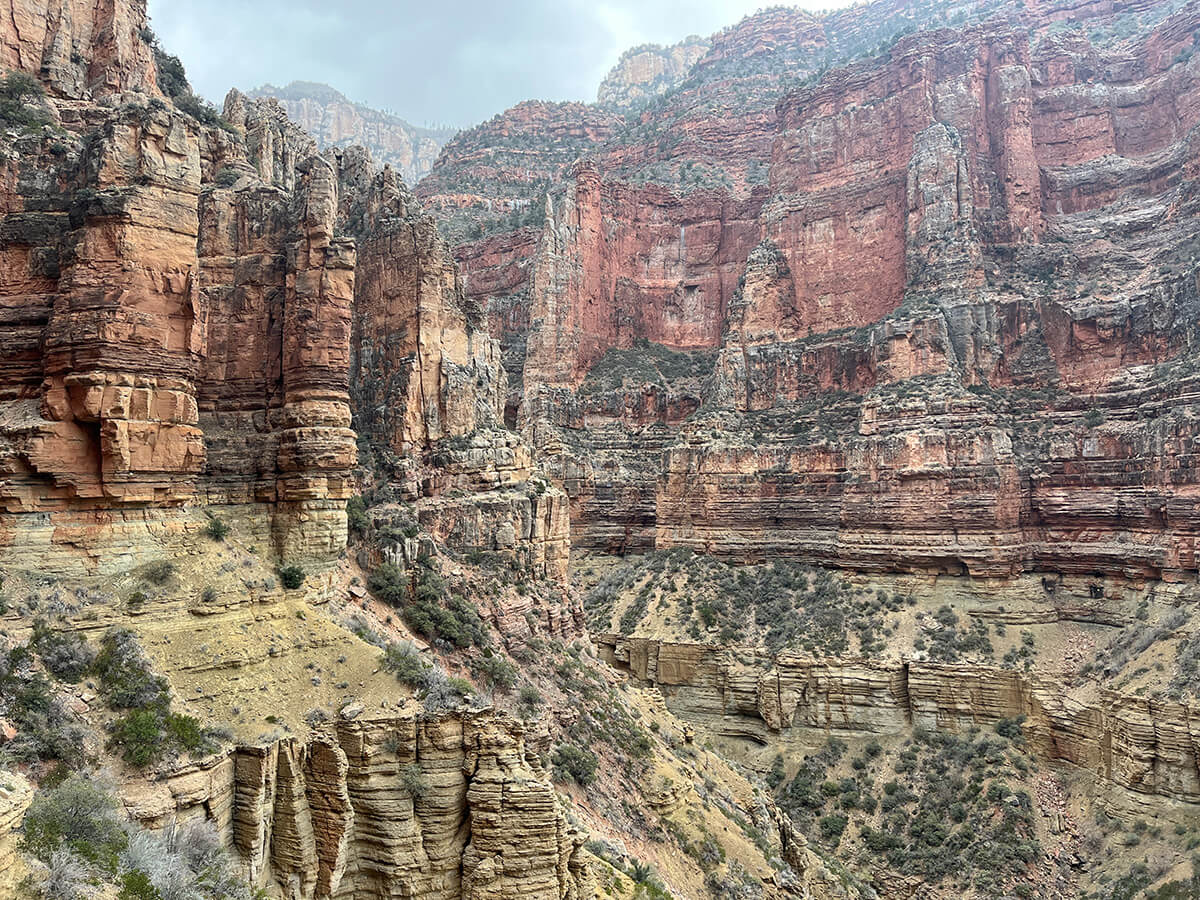
This year, for the first time on an Exo Death Hike, the entire hike took place on an established trail. We embarked upon a Rim-to-Rim-to-Rim hike of the Grand Canyon. Starting at the South Rim, we descended more than 4,700' in elevation down the South Kaibab trail. Crossing the Colorado River, we continued putting on miles in the depths of the Canyon before ascending more than 5,800' up the North Kaibab Trail to the Grand Canyon's North Rim.
From one side of the Grand Canyon to the other. And back again. In total, we hiked more than 50 miles, climbed more than 12,000' in elevation, and descended the same amount.
WHAT IS THE EXO DEATH HIKE?
If you are unfamiliar with the Exo Death Hike, you can catch up on the backstory at the links below. The short background is that the Death Hike started as nothing more than a group of buddies who wanted to see how far they could push themselves in the backcountry.
Since that first hike in 2016, the Death Hike has been different each year. New places. New challenges. New formats.
We have podcast recaps and stories from previous Death Hikes in 2016, 2017, 2018, 2019, 2021, 2022, and 2023.
The "Life-Changing Lessons from the Exo Death Hike" article also has some great takeaways, photos, and a gear list from previous years' hikes.
WATCH A GLIMPSE. HEAR THE FULL STORY.
In the video below you can get a glimpse of this year's hike. Justin (@themtnexperience) filmed some pre-hike interviews, and then took the camera along to capture some of the hike. With 20+ guys on the hike, who are spread out over many miles, and each having unique experiences, it is impossible to film everything, or show everyone's experience. This behind-the-scenes glimpse will show you a bit about the participants, the terrain, and the conditions encountered...
To hear the full story of this year's hike, including detailed accounts and takeaways from several of the participants, be sure to listen to Episodes 457 and 458 of the Hunt Backcountry Podcast...
Spotify | Apple Podcasts | Download
Spotify | Apple Podcasts | Download
For the remainder of this article, I (Mark) will include specifics on how I prepared for this year's hike, what I used on the hike, and some of the takeaways I have from the hike.
TRAINING
To train for something like this, you obviously want to hike a good amount. And specifically try to get as much elevation gain/loss in your training as possible. Most of my training hikes were "repeats" on hills, to maximize how much time I spent ascending and descending. I also carried more weight on my training hikes than I expected to carry for the Death Hike itself.
In addition to just hiking, focusing on lower body strength and muscular endurance is incredibly important. That doesn't mean you have to live in the gym or try to squat super heavy. Using a dumbbell, kettlebell, or weighted backpack is great for movements like weighted step-ups, lunges, split squats, single-leg deadlifts, and similar exercises.

One of the lessons I have learned over the years is to ensure that I am working in all directions and not just repeating forward motions. So when it comes to things like steps-ups and lunges, I purposely do lateral (sideways) repetitions, not just forward movements.
A big part of my training was added mobility work to ensure that I stayed healthy and had a good range of motion in the hips, knees, and ankles. This included a lot of band work and step-downs.
I will be filming some examples of the strength and mobility work that supplemented my hiking, so be sure to subscribe to our YouTube channel if you want to see that when it is released.
FOOTWEAR
This year's hike in the Grand Canyon was all on a hard-packed trail. And while there were some steps/drops, rocks, and ruts, there wasn't a lot of technical terrain. I have worn proper hunting/hiking boots on some previous Death Hikes, which included a lot of off-trail movement. But trail running shoes were the perfect choice for this year's adventure in the Grand Canyon.
I wore Topo Athletic Mtn Racer 2 shoes this year, which were fantastic.
I sized up a half-size, giving my toes room and ensuring they weren't jamming into the front of the shoe on long, steep descents. The Topo Athletic shoes also have a generally wider foot box, which is important to accommodate swelling that can easily occur when you are on your feet for hours on end, covering 50+ miles. Another popular choice from this year's Death Hike participants was Altra trail running shoes, which also have a wider toe box.

For socks, I used an Injini Liner Sock under Darn Tough Micro Crew socks. This combination was absolutely perfect. In fact, I didn't change my socks once during all 50+ miles. I never had a hot spot, blister, or any discomfort.
(Side note: I generally recommend changing socks frequently [every 2-4 hours] on extended efforts like this.)
While I don't always hike in toe socks, the toe separation provided by the Injini socks is especially helpful on long efforts like this. They keep your feet cooler, prevent skin-on-skin rubbing, and are great for blister prevention in general.
CLOTHING
It isn't uncommon to experience temperature swings of more than 60 degrees when hiking the Grand Canyon. A chilly, 30-degree start at the top of the Canyon could easily turn into 90+ degree heat at the bottom of the Canyon.
As with all hikes, it is important to start cooler than you'd like, knowing that you will quickly warm up as you begin hiking.
At the start of the hike, I wore my favorite workout shorts (5.11 PT-R Havoc), a lightweight sun hoody (Sitka Core Lightweight), and an ultralight wind shell (Outdoor Vitals Nebo). I carried a lightweight puffy jacket to keep me warm when stopping for breaks. I also had a grid fleece, which proved to be critical for the end of the hike when the temperatures plummeted after sunset, the wind was blowing fierce, and snow was swirling in every direction.
NUTRITION
It is hard to overstate the importance of nutrition for an effort like this. There is a lot to learn about having enough calories versus having too many calories. About having the right type of macronutrients (carbohydrates, fats, and proteins). About finding the specific foods that work for your palette and preferences. About managing hydration and electrolytes. And more.

Our friend Kyle Kamp from Valley-to-Peak Nutrition has been instrumental in helping us fine-tune our nutrition over the years.
My nutrition and hydration for this year's hike were right on point. I had enough calories, never experienced any stomach upset, always had food that sounded/tasted good at the time, and kept me energized without "bonking" over the long miles.
All-in-all, I consumed over 4,800 calories during the hike and another 1,000 calories in the 1-2 hours after the hike. While that is a TON of calories, it doesn't even replace everything I burned during this effort.
If you want to see the specific items I consumed, here is a spreadsheet that outlines everything…
MARK'S 2024 DEATH HIKE FOOD LIST
TOP TAKEAWAYS
There isn't enough space in this article to document all of the lessons learned on this hike, the nuance of what I have learned on past year's Death Hikes, or to express the value that I get from challenges like this.
I would encourage you to check out the podcast(s) and other articles linked at the beginning of this article if you want to learn more.
But to wrap up I wanted to quickly highlight a few of the top takeaways from this year's experience...
- I have never felt stronger or experienced less muscle fatigue, thanks in part to adding strength training to the training hikes leading up to this year's Death Hike
- The lack of issues I had with my feet, due to my sock and shoe choices, enabled me to save time and discomfort compared to a lot of the other guys who were managing and enduring the discomfort of blisters
- Being strategic with your nutrition strategy and testing your nutrition on long training efforts is well worth the time spent in researching and experimentation
- Voltaren works incredibly well for me and is far better than taking oral anti-inflammatories. (Disclaimer: that is not medical advice.)
- Do it. Stop reading this article right now and go make a plan to complete a challenge that pushes you out of your comfort zone. Seriously... Commit Right Now.
Mark Huelsing is the host of the Hunt Backcountry Podcast and works at Exo Mtn Gear — though he's never been able to figure out his job title. Connect with Mark by sending him an email (mark at exomtngear.com) or DM @MarkTheFark on Instagram.
